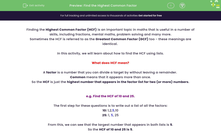Finding the Highest Common Factor (HCF) is an important topic in maths that is useful in a number of skills, including fractions, mental maths, problem solving and many more.
Sometimes the HCF is referred to as the Greatest Common Factor (GCF) too - these meanings are identical.
In this activity, we will learn about how to find the HCF using lists.
What does HCF mean?
A factor is a number that you can divide a target by without leaving a remainder.
Common means that it appears more than once.
So the HCF is just the highest number that appears in the factor list for two (or more) numbers.
e.g. Find the HCF of 10 and 25.
The first step for these questions is to write out a list of all the factors:
10: 1,2,5,10
25: 1, 5, 25
From this, we can see that the largest number that appears in both lists is 5.
So the HCF of 10 and 25 is 5.
In this activity, you will find the HCFs of number pairs by creating lists and finding the highest option which appears in both lists.
You may want to have a pen and paper handy so that you can write out your lists before selecting your answers.
Want a bit more help with this before you begin? Why not watch this short video?








